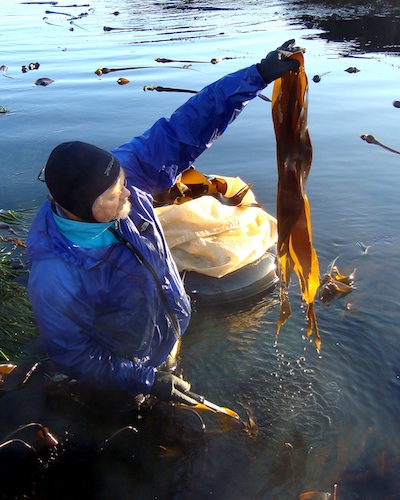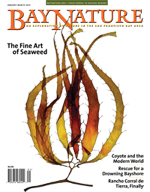
After growing up in one of the driest places in California (in Barstow on the edge of the Mojave Desert), Larry Knowles wound up living in one of the wettest—the coast of Mendocino. But there’s been a constant in his life as well: A quest for a sustainable way of life that integrates a strong connection to the natural world. Knowles is the owner of Rising Tide Sea Vegetables, which practices the sustainable harvesting of kelp and seaweed along the Northern California coast and educates consumers about the rich and diverse intertidal zone.
BN: Are you a California native? How did you end up in Mendocino?
LK: I am a native, but from Southern California. My father was a welder. My family originally came to California because he got a job on the railroad. I grew up in Barstow, on the Mojave River.
When I was 15 my parents split up and I moved with my Mom to Ojai, where I had kind of an awakening. Living in Ojai in the 70s and 80s really cemented my interest in alternative lifestyles and natural foods. I got turned on to the philosopher Krishnamurti. I tuned in and dropped out, as they say, not on drugs, but through meditation.
In the course of my life journey, I got together with a woman who wanted to move up to the North Coast. That relationship didn’t work out, but I fell more and more in love with the coastal environment and the ocean, and especially snorkeling in the ocean.
BN: So how and when did you get involved with harvesting seaweed for a living?
LK: It all started with a woman. In 1994 I met Kate Marianchild, who had started Rising Tide Sea Vegetables the early 80s. I was taken by Kate and I was also taken by the idea of harvesting seaweed and growing the business, given my lifelong interest in Right Livelihood. I started co-managing Rising Tide in 1995 and took ownership 11 years later.
BN: What’s the scope of the sea vegetable industry?
LK: There are a few people who do it, including a few other businesses on the North Coast. Our business has been in operation since 1981, and there’s another one that has been operating since ’80. At this point, we harvest a greater volume.
BN: Where is it harvested?
There are two main locations in the United States where culinary quality seaweed is harvested. On the West Coast, the epicenter is Mendocino Country, and in Maine. In both areas small-scale outfits focus on producing artisanal, culinary grade, edible seaweed.
The actual practices of the different producers are pretty similar, with an awareness of sustainability and environmental impact across the board.
BN: So how do you harvest seaweed and kelp sustainably?
LK: We hand cut all the seaweed we harvest from the beds where they occur naturally. We employ specific harvesting techniques for each species in order to insure reproductive success and overall ecosystem vitality. We leave a lot of plants untouched in each area we harvest.
Also, access is limited by the rocky cliffs here on the Mendocino coast, so most areas here are natural reserves simply because they are too remote to get to by our two methods – on foot or by kayak.
(FYI, TMI: “kelp” is a general term for any number of large “brown” seaweeds. There are three main Families of algae; Brown, Red, and Green. Every seaweed we harvest except Nori is a kelp.)
BN: Do you have formal training in this industry?
LK: Formal training? No, I’m a drop out, remember? There really is no formal training for the production of seaweed. However, there are rules and guidelines, established by the Department of Fish and Wildlife, and you must have a kelp harvesting license. Members of the industry have worked with the Department to help craft the guidelines to protect critical species. Whenever I train new people for my business, I make sure that they know all this.
BN: Is the seaweed industry highly regulated? Does that work for or against you?
LK: Regulatory agencies actually tend to do more good in areas that aren’t politically charged. Both edible and industrial seaweed regulations have been sensibly, scientifically, and pro-actively designed. Essentially, seaweed production north of San Francisco up to the Oregon border has been restricted to hand-harvested, edible products by the California Department of Fish and Wildlife. There are a few areas south of San Francisco and down to the Mexican border where Giant Kelp (macrocystis) is harvested on a more industrial scale with restrictions on how much and where it can be harvested.
BN: What’s the work like??
LK: The North Coast is very rough. It’s extremely physically demanding. We go out during the minus tides, early in the morning, harvest, and get back to lay it out to dry. And while the tide comes in, we prepare for the next day’s harvest. Also, each one of these species has a very specific biology, where and when they mature and bloom. We have to coordinate all that with the weather – sometimes it’s just too rough to harvest at a certain location. Another big challenge is marketing. We’re selling something that’s kind of exotic, a wild-crafted product, and we’re competing with the price point of Asian companies, which have different labor practices and more developed aquaculture, and they operate in a culture where the consumption of sea vegetables is more ingrained.
BN: What are your greatest successes?
LK: Interestingly, I think one of the big successes is that I’m really confident in the sustainability of seaweed. I’m really pleased to be in a business that has minimal impact on the ecosystem. I feel really strongly about that. And then, it’s getting people healthy food. I see that as a real success. I also value the educational aspects of it. For instance I love to give seaweed walks. I love to talk to people about how the nutrient cycle works.
BN: What is your favorite seaweed to eat?
LK: My very favorite is dulse, which ironically only grows in the Atlantic (so much for Larry being a locavore). I also love kombu for the umami it adds to soup and sauces, as well as sea palm that adds a tasty green “noodle” to salads (we have a yummy recipe on the back of our Sea Palm package!).
BN: What is your favorite Rising Tide product?
My favorite Rising Tide product is our Maple Chewnami Nibbles, a sesame/ seaweed candy we make at our kitchen here in Fort Bragg. FYI, TMI again, we also operate Chubby’s Shared Use Commercial Kitchen in Fort Bragg, with the mission of incubating small local specialty food businesses.
BN: What is your favorite outdoor destination in Northern California?
LK: I’m split. My first choice is the Mendocino coast. I like to snorkel, free dive, and kayak. One of my favorite locations is Van Damme State Park. It’s about four miles south of Mendocino. I love to explore the tunnels and sea caves, where you can see sponges and nudibranchs. If I had a second choice it would be the Sierra or the Trinity Alps.
>> Learn more about Rising Tide Sea Vegetables at the company’s website, loveseaweed.com.


